Tips for Creating Awesome LinkedIn Content
- 1. Keep It Simple.
- 2. Keep It Digestible
- 3. Identify Your Audience.
- 4. Tell Stories.
- 5. Post Regularly.
- 6. Use Practical Headlines.
- 7. Include an Image.
As the social hub for professionals, LinkedIn is often used to check out potential new hires (or, in the case of employees, potential employers). However, it can also be used for marketing your products and services to your audience. If you’re not yet using LinkedIn content to attract and engage your audience, you’re already a step behind.
LinkedIn can serve as a valuable tool within your greater content marketing strategy, but you have to be able to effectively manage your posting schedule. The best way to do this is by creating a LinkedIn content calendar.
The World of LinkedIn Content
There’s no question that LinkedIn is an essential channel for content marketing, especially for building B2B relationships. In fact, marketers see up to 2x conversion rates on LinkedIn, and the platform boasts that "40% of B2B marketers surveyed indicated LinkedIn as the most effective channel for driving high-quality leads."
What’s the purpose of creating content on LinkedIn, though? Well, as mentioned by LinkedIn: "Audiences exposed to brand and acquisition messages on LinkedIn are 6x more likely to convert."
Marketing professionals praise LinkedIn as the best hub for information and material – LinkedIn was rated the No. 1 platform for B2B lead generation.
But with an abundance of content on the platform, isn’t there a high risk of overlap? Doesn’t it get dry? Not necessarily. Here’s why: There are tons of different kinds of LinkedIn content, and that creates an engaging, diverse range of material for you to digest.
Different kinds of LinkedIn content include the following:
How To Posts
How to posts have one primary goal – to teach the reader something. It’s informational content that provides instructions on how to complete a task. This could include any number of topics, from “how to develop your content marketing strategy” to “how to train your dragon.”
Also, if you’ve noticed – this article could be considered a “how to” post because we’ll eventually be guiding you through how to create a LinkedIn content calendar.
List Posts
List posts often encompass “top” or “best” categories, and provide insight into specific topics. For example, you might find list posts that have titles like “The top 5 thought leaders in marketing” or “The best ways to procrastinate while still getting things done.”
Templates
Templates are guidelines or worksheets that readers can use to shape the creation of material. For example, HubSpot has a bunch of different useful templates available, such as their template to help marketing professionals develop buyer personas — and they have a full-on buyer persona builder you can use.
Ebooks
An ebook is an "electronic book." Ebooks used in online content strategies are typically shorter than a regular book. Your ebooks can provide valuable information to your audience and help guide them along your sales funnel. So it’s important to distribute them across relevant professional channels like LinkedIn.
On LinkedIn, you can increase the reach of your ebook content to get it in front of prospects who might not find your ebooks otherwise.
Webinars
Webinars aren’t so much involved with posting content as hosting an online conference that provides information and topical commentary on your industry. As a professional hub, LinkedIn is a great place to hold webinars for your targeted audience.
Live Events
LinkedIn is especially good for promoting upcoming live events. Whether you’re hosting or attending a professional event, creating a promotion complete with visual content, a brief descriptor, and a strongly enticing CTA will encourage your target audience to attend!
SlideShares
SlideShare is a LinkedIn tool that allows you to host professional presentations online for a wide audience. You can upload slideshow presentations, videos, infographics, and much more. It’s a hub for a massive amount of informational content.
Video
Video content is pretty much exactly what you would assume — recorded content that uses visual and audio elements. LinkedIn allows you to upload videos, which can be incredibly influential on your audience.
Of course, "video" can cover a wide variety of subtypes. For example, are you sharing a recorded webinar, an animated "how to" video, or a production that uses professional voice actors and documentary-style footage?
Images Featuring Statistics
Reading about an impressive statistic is sometimes less impressive when it’s stuffed amongst other content in a report. To make important statistics more impactful, get a little creative with Photoshop and overlay core text on a relevant image that ties into the campaign or research results.
Company Updates
LinkedIn is a great place to post quick company updates to keep your audience and partners in the loop at all times. While you don’t necessarily need to share a whole article to broadcast a new hire, you can (and should) use one for something like a new product launch.
For the smaller stuff (like introducing that new intern named Steve who's on loan from a college professional training course with an eye for getting a full-time position once they graduate), a simple status update will suffice nicely.
Original Research
Conducting original research and sharing it on LinkedIn is a great way to establish yourself as a thought leader within your industry. It puts you at the forefront of conversations and development within your area and helps you stand out from your competitors.
Third-Party Content
Engaging with industry-relevant content produced by third parties will show that you’re active within the greater conversation of your area of expertise. Share insightful and impactful articles that you find valuable, praise a good video campaign, etc., and your audience will appreciate your breadth of attention.
7 Tips for Creating Awesome LinkedIn Content
Here are some tips that may help you create awesome LinkedIn content that helps increase engagement:
1. Keep It Simple.
Your content should be simple and well organized so your readers can scan and absorb the information you are presenting them with ease. Try to avoid content that is convoluted and unnecessary.
Another way to keep it simple is to avoid spamming your audience with content. Make a simple schedule for posting and revisiting old content every six months to a year to refresh it and repost it.
2. Keep It Digestible
As a corollary to the "keep it simple" point, if you're doing an in-depth dive into a complicated subject, consider breaking it up into several smaller, easier-to-digest content pieces.
After you complete your series, you could make an "omnibus" collection version as a premium content offer that can be downloaded from your website. This could be a good way to add new content offers on your site to collect customer information.
3. Identify Your Audience.
Determine who your audience is early on so all of the content you create is targeted and useful to them. If you know about a certain industry or a specific department, then you may begin creating content centered around those things.
This way, you can tackle issues in your audience's industry or departments to provide them with value and actionable content on how they may go about alleviating some of these issues.
4. Tell Stories.
You may be an expert in your industry, but when you write articles, make sure to be human and tell a story with your content. It is unlikely that your followers will want to read a long article that consists primarily of rambling lists of facts and statistics with nothing to contextualize them or make them meaningful.
People don't connect with statistics; they connect with stories. Your audience will likely be more willing to engage with your content when you tell a story that they relate to.
5. Post Regularly.
Consistency is key to any content strategy, and it is especially crucial to your LinkedIn success. Select consistent dates and times to post your content so your followers know when to expect new content from you to make it easier for your audience to get in the habit of tuning in.
6. Create Engaging Titles for Your LinkedIn Content.
People like to click on and read content with actionable information or interesting information that impacts them in some way. This helps improve the chances that people scrolling through LinkedIn will see and click on your content.
Doing some research into your audience can help you identify the best kinds of content (and thus, content titles) to help you engage with your audience.
Some examples of great LinkedIn post titles highlighted by HubSpot include:
- How ChatGPT is Changing the Game
- Now Is the Time to Build the Workplace of the Future
- 17 of the Best Tools For Any Entrepreneur Looking to Scale Their Business
- 20 CEO Lessons Learned at HubSpot on the Journey from $0 to $20 Billion
- Imposter Syndrome - Its Prevalence In Professional Women And How To Overcome It
- The Truth on Authentic Inclusive Marketing and How to Make It Happen
You might notice that these titles cover a variety of content types. Some cover major shifts in the industry, while others provide tips, and some are "listicles" that provide examples for readers to learn from.
7. Include an Image.
Social network posts and content with images attract more engagement and typically garner more shares. Include a relevant and engaging cover image for your LinkedIn article to visually engage your readers.
In addition to adding a cover image, embed images into the body of your text if you are writing an article to break up your text into small scannable pieces. Make sure you have permission to use the images you select before publishing or posting content.
5 of the Best LinkedIn Content Examples to Study
LinkedIn hosts a variety of great content options that get a user's attention. Here are five of the best examples we found that may help you choose content types that are good for your LinkedIn content strategy:
1. Bank of America: Videos
Videos aren't just used for other social media platforms. They can also be used in the professional world on LinkedIn. One survey determined that about 83 percent of people prefer video over text or audio of that topic.
Bank of America often publishes short videos on LinkedIn that range from about 25 seconds to about seven minutes to engage with their followers.
They don't just post content related to banking or finance. They also post videos about things that are helpful for the community, that confirm their stance on social issues, and that highlight their company culture by showcasing exceptional teammates.
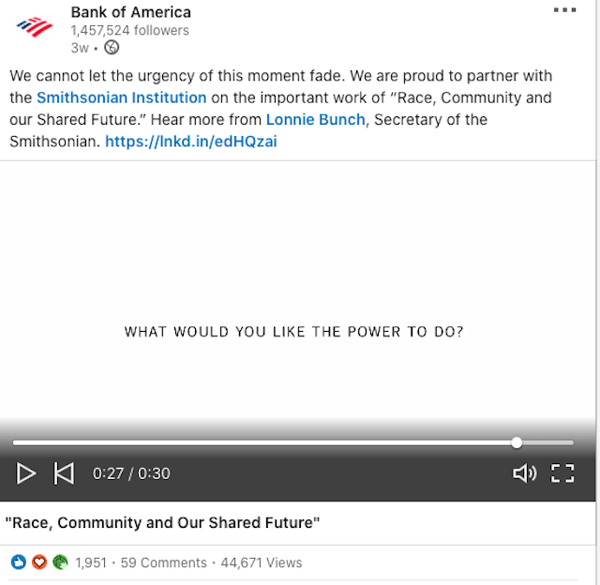
Bank of America enhances its brand's voice and shows that they are a company that cares with its meaningful videos that have thousands of views and shares.
2. Contently: Infographics
People love statistics and images. What's a better way to present these two forms of content than in a well-thought-out and visually appealing infographic?
Contently shares short infographics with one or two stats on LinkedIn content ads to attract followers and potential customers.
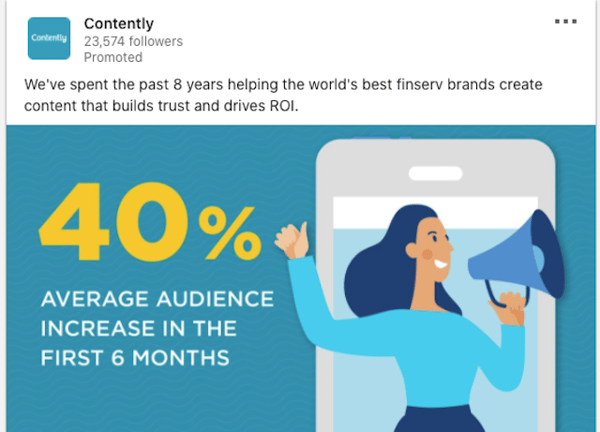
3. Lemonade: How To Articles
"How to" posts are often clicked on the most when people want to learn something fast. The internet is an open book, and when you position yourself as an expert, you can provide your followers with tips and steps to help them in their field.
Lemonade, an insurance company, posts "how to" content for a variety of subjects to appeal to their audience.
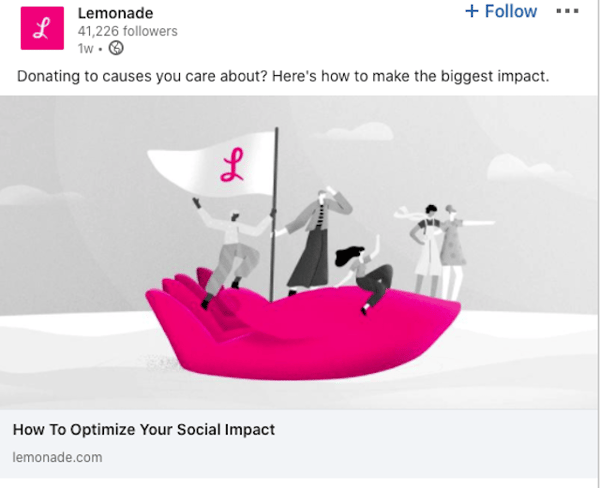
4. Gary Vaynerchuk: Opinions
You may be caught up by thinking that no one wants to hear or read your opinion, but you'd be wrong. Opinion content that gives readers your perspective on a topic can perform incredibly well.
For example, Gary Vaynerchuk is a well-known motivational speaker who frequently posts his takes about business topics for aspiring entrepreneurs. He frequently combines experience-backed insights with motivational (and sometimes charmingly crass) speeches mixed in.
Over time, "GaryVee" has built an enormous following with his motivational and opinion-based content, which he has leveraged to fuel his business ventures. Here's an example of a piece he wrote about ChatGPT on LinkedIn:
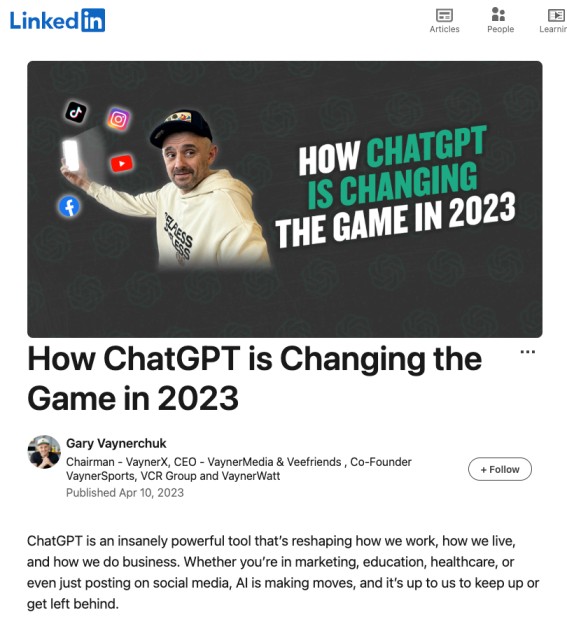
5. McKinsey & Company: Long-Form Content
Most social media sites aren't dedicated to long-form content, but on LinkedIn, people like it! If your posts contain between 1300 to 2000 words, they perform better with an increase in post views, comments, shares, and likes.
McKinsey & Company posts long-form content about technology, leadership, and business to provide their followers with the most comprehensive information they can.
Now that you have some great examples and tips to help you create valuable LinkedIn content, you can move on and start to organize your content using a content calendar.
Why You Need a LinkedIn Content Calendar
As with every marketing initiative, you need a documented plan in place to set yourself up for success. If you launch a new campaign without first developing an organized, comprehensive strategy, it can easily crash and burn.
Luckily, content calendars are here to save the day. LinkedIn content calendars help you plan out your publication schedule, but they can also help you in a myriad of other ways as well, such as the following:
- It gives you time to generate new ideas for the short and long term.
- It helps you align messaging with certain initiatives.
- It assists in planning ahead for noteworthy events.
- It guides with mapping your content to certain themed campaigns.
- It shows your entire team the bird’s eye view of all things.
- It ensures content is persona-targeted and aligned with the buyer journey.
Elements of an Awesome LinkedIn Content Calendar
For your LinkedIn content calendar to be successful, each piece of content that gets scheduled into it needs to possess the following elements:
Author
First and foremost, who is responsible for creating this content? Who’s going to write this blog post, record and edit this video, etc.? It’s important to assign these tasks ahead of time so your content team members can prepare and schedule time for creation.
Working Title
A piece of content without a title is like a novel with no name. It lacks direction, and honestly, do you even know what it’s about? No. You don’t need a finalized title immediately, but at least come up with a working title to get a basic idea of what the content will be.
Summary of Content
The summary of content is the most important element to include on your LinkedIn content calendar. For starters, it helps the author know what exactly the content they’re producing is about. But it can also provide direction for the piece as well. If you’re looking to have it take a specific point of view or display information from a certain angle.
This could include a list of headers to help you get the "skeleton" of your content ready before you (or the writer assigned to the piece) fleshes it out.
Content Format
Choosing a content format is a basic, but important, task. What kind of format is the content going to take? Is it a blog post, a video, an event promotion, or a simple status update about Steve from accounting? Add this detail up front.
Targeted Keywords
This element is essential for your SEO. Including keywords in your calendar ahead of time will allow the author to incorporate them within the content more efficiently during the creation process. This method will streamline your SEO efforts, making them much smoother than researching keywords and plugging them in after initial creation.
Buyer Persona
One of the most important elements of quality content is understanding the audience of the content. Developing buyer personas will help you determine the purpose of the article, such as the pain points it addresses, and what it seeks to accomplish.
If you don’t know who you’re writing the article for, then how do you know what to discuss and how to express your points convincingly?
Scheduled Publication
Possibly the most obvious element given that this is an article about editorial calendars – make sure you remember to actually schedule the article into your calendar, so your team can know who needs to create what content and when.
Staying on top of this task will help your team maintain organization and stay on schedule to achieve goals.
How to Create Your LinkedIn Content Marketing Strategy
Unfortunately, you can’t snap your fingers and have your content calendar appear before your very eyes. Wouldn’t that be nice? Nevertheless, we’ve put together a step-by-step guide to help you build yours.
1. Set Your Goal.
Before you develop a LinkedIn content marketing strategy, you have to determine what you hope to achieve from it. Are you looking to boost traffic to your website? Increase brand awareness? Generate leads? Maybe even foster a B2B partnership?
Once you figure out what the overall goal of the strategy is, this will help you better shape it to create more efficient campaigns and effective, targeted content aimed at achieving that goal.
2. Audit Your Existing Content.
To build a better LinkedIn content strategy, you first have to audit your existing content presence. What kind of content are you already posting on LinkedIn? How is it performing? Understanding this will help you understand how you can improve your content.
Where are the gaps in your content? For example, do you only post blog articles and no videos? Are there important topics within your industry that you don't address or discuss within your content? Filling these gaps could help you increase your reach on LinkedIn (or any other content platform, for that matter).
3. Research Trends, Topics, and Keywords.
In order to know what kind of content you should be posting, you need to research the latest trends, topics, and keywords within your industry.
What information is your audience looking for right now? What are people talking about? Do some digging into your competitors' content to see what they're writing about and how you can improve upon it.
Put together a list of key topics that are relevant to your industry, and do thorough keyword research for each one. There are plenty of great online keyword research tools available, such as Moz.
4. Analyze and Evolve.
The work isn't done once you post your new content to LinkedIn. To build more effective campaigns and create more efficient, impactful content, you need to analyze how your material performs so you can determine what is and isn't working.
It may take a while to perfect the art of reaching your target audience with valuable content that they want. Keep track of which content gets high response and share rates, and see if you can find patterns within the engagement.
Develop Your Content Strategy for a Better Overall LinkedIn Presence
Developing a LinkedIn content strategy is one of the best ways to improve your professional, advantageous use of LinkedIn. Doing so can have a myriad of different benefits for your company – it can improve your recruitment marketing strategy, drive new leads, and foster B2B partnerships.
With a LinkedIn content plan in place, and an organized editorial calendar to manage it, you and your team will be ready to attract and engage targeted users to drive marketing results.

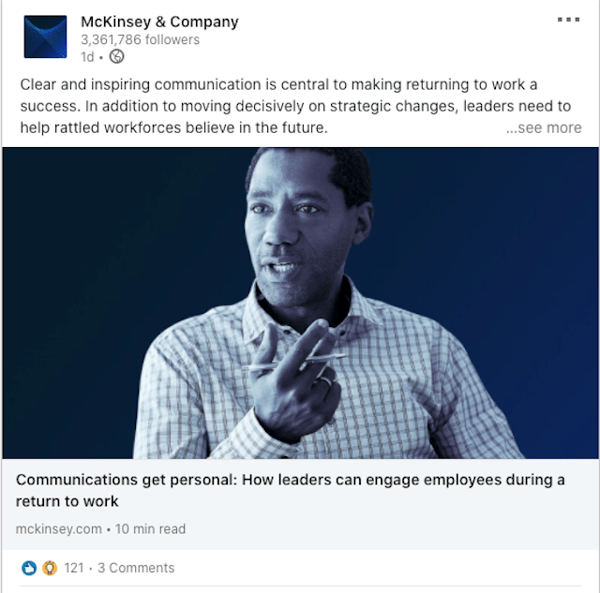
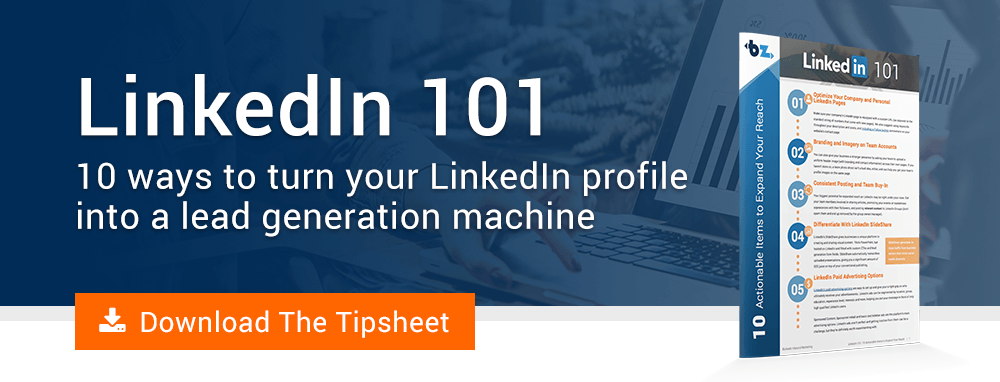
Douglas Phillips
Former military brat, graduated from Leilehua High School in Wahiawa, Hawaii in 2001. After earning my Bachelor's in English/Professional Writing, took on a job as a writer here at Bluleadz.